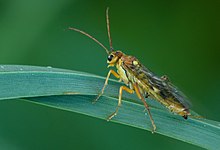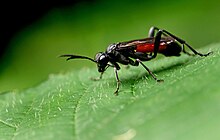Tenthredinidae
| Tenthredinidae | |
|---|---|

| |
| FemaleTenthredopsis sordida | |
| Scientific classification | |
| Domain: | Eukaryota |
| Kingdom: | Animalia |
| Phylum: | Arthropoda |
| Class: | Insecta |
| Order: | Hymenoptera |
| Suborder: | Symphyta |
| Superfamily: | Tenthredinoidea |
| Family: | Tenthredinidae Latreille,1802[1] |
| Type genus | |
| Tenthredo | |
| Subfamilies | |
|
Allantinae | |

Tenthredinidaeis the largest family ofsawflies,with well over 7,500 species worldwide,[2]divided into 430 genera.Larvaeareherbivoresand typically feed on the foliage of trees and shrubs, with occasional exceptions that areleaf miners,stem borers, orgallmakers. The larvae of externally feeding species resemble small caterpillars. As with allhymenopterans,common sawflies undergo complete metamorphosis.
The family has no easily seen diagnostic features, though the combination of five to nine antennalflagellomeresplus a clear separation of the firstabdominaltergumfrom themetapleuroncan reliably separate them. These sawflies are often black or brown, and 3 to 20 mm long. Like other sawflies, they lack the slender "wasp-waist", orpetiole,between the thorax and abdomen, characteristic of manyhymenopterans.Themesosomaand themetasomaare instead broadly joined. The Tenthredinidae are also often somewhat dorsoventrally flattened, which will distinguish them at least from the slendercephids(which, together with the common sawflies, comprise many of the Nearctic species of Symphyta).
Females use their saw-likeovipositorsto cut slits through barks of twigs, into which translucent eggs are wedged, which damages the trees. They are common in meadows, and in forest glades near rapid streams. Adults eat little, while larvae feed on foliage of streamside trees and shrubs, especially willow.
A number of species and genera have been described from thefossil recordsuch asEriocampa tulameenensisandPseudosiobla campbelliofBritish Columbia.[3]
Life cycle ofCladius difformis
[edit]-
Larva
-
Pupa, dorsal view
-
Pupa, ventral view
-
Female
-
Male



Taxonomy
[edit]The Tenthredinidae are divided into seven subfamilies. Of the 430 genera, nine contain more than 50 species.
Subfamilies and genera
[edit]Subfamilies and genera within this family include:[4]
- SubfamilyAllantinae
- SubfamilyBlennocampinae
- ArdisKonow, 1886
- BlennocampaHartig, 1837
- CladardisBenson, 1952
- ClaremontiaRohwer, 1909
- EutomostethusEnslin, 1914
- HalidamiaBenson, 1939
- HoplocampoidesEnslin, 1913
- MonardisBenson, 1952
- MonophadnoidesAshmead, 1898
- MonophadnusHartig, 1837
- ParacharactusMacGillivray, 1908
- PericlistaKonow, 1886
- PhymatoceraDahlbom, 1835
- RhadinoceraeaKonow, 1886
- StethomostusBenson, 1939
- TomostethusKonow, 1886
- SubfamilyHeterarthrinae
- CaliroaO. Costa, 1859
- EndelomyiaAshmead, 1898
- FenellaWestwood, 1840
- FenusaLeach, 11817
- HeterarthrusStephens, 1835
- MessaLeach, 1817
- MetallusForbes, 1885
- ParnaBenson, 1936
- ProfenusaMacGillivray, 1914
- RocaliaTakeuchi, 1952
- ScolioneuraKonow, 1890
- SubfamilyNematinae
- AmauronematusKonow, 1890
- AnoplonyxMarlatt, 1896
- CladiusIlliger, 1807
- CroesusLeach, 1817
- DecanematusMalaise, 1931
- DineuraDahlbom, 1835
- EiteliusKontuniemi, 1966
- EndophytusHering, 1934
- EupontaniaZinovjev, 1985
- EuuraNewman, 1837
- HemichroaStephens, 1835
- HoplocampaHartig, 1837
- MesoneuraHartig, 1837
- MicronematusKonow, 1890
- NematinusRohwer, 1911
- NematusPanzer, 1801
- PachynematusKonow, 1890
- PikonemaRoss, 1937
- PlatycampusSchiødte, 1839
- PontaniaCosta, 1859
- PontopristiaMalaise, 1921
- PriophorusDahlbom, 1835
- PristiphoraLatreille, 1810
- PseudodineuraKonow, 1885
- SharliphoraWong, 1969
- StauronematusBenson, 1953
- TrichiocampusHartig, 1837
- SubfamilySelandriinae
- AneugmenusHartig, 1837
- BirkaMalaise, 1944
- BrachythopsHaliday, 1839
- DolerusJurine, 1807
- HemitaxonusAshmead, 1898
- HeptamelusHaliday, 1855
- LoderusKonow, 1890
- NesoselandriaRohwer, 1910
- PseudoheptamelusConde, 1932
- SelandriaLeach, 1817
- StrombocerinaMalaise, 1942
- StrongylogasterDahlbom, 1835
- SubfamilySusaninae
- SusanaRohwer & Middleton, 1932
- SubfamilyTenthredininae
- AglaostigmaKirby, 1882
- EurogasterZirngiebl, 1953
- IschyroceraeaKiaer, 1898
- MacrophyaDahlbom, 1835
- PachyprotasisHartig, 1837
- PerineuraHartig, 1837
- RhogogasterKonow, 1884
- SioblaCameron, 1877
- TenthredoLinnaeus, 1758
- TenthredopsisA. Costa, 1859
- TyloceridiusMalaise, 1945
- UssurinusMalaise, 1931
Phylogeny
[edit]Of these subfamilies, Tenthredininae and Allantinae aresister groups,and together form a sister group to the Nematinae.[5]
References
[edit]- ^Liston et al 2014.
- ^Davis, Robert B; Baldauf, Sandra L; Mayhew, Peter J (2010)."The origins of species richness in the Hymenoptera: insights from a family-level supertree".BMC Evolutionary Biology.10(1): 109.Bibcode:2010BMCEE..10..109D.doi:10.1186/1471-2148-10-109.ISSN1471-2148.PMC2873417.PMID20423463.
- ^Rice, H.M.A. (1968). "Two Tertiary sawflies, (Hymenoptera – Tenthredinidae), from British Columbia".Geological Survey of Canada.67(59): 1–21.
- ^Funet
- ^Song et al 2016.
Bibliography
[edit]- Asaro, Christopher (2008-08-11).Sawflies (Hymenoptera: Symphyta).Springer. pp. 3250–3252.ISBN9781402062421.,inCapinera (2008)
- Boevé, Jean-Luc (2008-08-11).Sawflies (Hymenoptera: Tenthredinidae).Springer. pp. 3252–3257.ISBN9781402062421.,inCapinera (2008)
- Capinera, John L., ed. (2008).Encyclopedia of Entomology(2nd ed.). Dordrecht: Springer.ISBN978-1-4020-6242-1.
- Blank, S.M.; Groll, E.K.; Liston, A.D.; Prous, M.; Taeger, A. (2012)."ECatSym - Electronic World Catalog of Symphyta (Insecta, Hymenoptera). Program version 4.0 beta, data version 39".Müncheberg: Digital Entomological Information.
- Blank, S.M.; Taeger, A. (1998).Comments on the taxonomy of Symphyta (Hymenoptera).pp. 141–174.,in Taeger, A. & Blank, S. M. (eds.), Pflanzenwespen Deutschlands (Hymenoptera, Symphyta) Kommentierte Bestandsaufname. Deutsches Entomologisches Institut, Goecke& Evers, Keltern.
- Goulet, Henri; Huber, John T., eds. (1993).Hymenoptera of the world: An identification guide to families(PDF).Ottawa:Agriculture Canada.ISBN978-0-660-14933-2.Archived fromthe original(PDF)on 2016-03-05.
- Liston, Andrew; Knight, Guy; Sheppard, David; Broad, Gavin; Livermore, Laurence (29 August 2014)."Checklist of British and Irish Hymenoptera - Sawflies, 'Symphyta'".Biodiversity Data Journal.2(2): e1168.doi:10.3897/BDJ.2.e1168.PMC4152835.PMID25197241.
- Smith, David R (September 1969).Nearctic sawflies I. Blennocampinae: Adults and larvae (Hymenoptera: Tenthredinidae)(Technical Bulletin 1397).Washington:US Department of Agriculture.Retrieved7 September2016.
- Smith, David R (September 1969).Nearctic sawflies II.Selandriinae: Adults and larvae (Hymenoptera: Tenthredinidae)(Technical Bulletin 1398).Washington:US Department of Agriculture.Retrieved8 September2016.
- Smith, David R (January 1971).Nearctic sawflies III. Heterarthrinae: Adults and larvae (Hymenoptera: Tenthredinidae)(Technical Bulletin 1420).Washington:US Department of Agriculture.Retrieved7 September2016.
- Smith, David R (June 1979).Nearctic sawflies IV. Allantinae: Adults and larvae (Hymenoptera: Tenthredinidae)(Technical Bulletin 1595).Washington:US Department of Agriculture.Retrieved30 August2016.
- Smith, David R (March 2003). "A Synopsis of the Sawflies (Hymenoptera: Symphyta) of America South of the United States: Tenthredinidae (Nematinae, Heterarthrinae, Tenthredininae)".Transactions of the American Entomological Society.129(1): 1–45.JSTOR25078795.
- Song, Sheng-Nan; Tang, Pu; Wei, Shu-Jun; Chen, Xue-Xin (16 February 2016)."Comparative and phylogenetic analysis of the mitochondrial genomes in basal hymenopterans".Scientific Reports.6:20972.Bibcode:2016NatSR...620972S.doi:10.1038/srep20972.PMC4754708.PMID26879745.
- Skvarla, Michael; Smith, David; Fisher, Danielle; Dowling, Ashley (9 May 2016)."Terrestrial arthropods of Steel Creek, Buffalo National River, Arkansas. II. Sawflies (Insecta: Hymenoptera:" Symphyta ")".Biodiversity Data Journal.4(4): e8830.doi:10.3897/BDJ.4.e8830.PMC4867044.PMID27222635.
External links
[edit]- Hymis deImage gallery





